Examination
To perform the work you will need a multimeter.
1. Remove the starter (see "Starter - removal and installation").
2. We clean the outer surface of the starter from dirt.
3. To check the traction relay, we connect its output "50" with the positive terminal of the battery, and the starter housing with a negative one. At the same time, for a working relay, the armature pushes the drive gear into the front cover window with a characteristic click.

4. To check the armature and stator windings, remove the back cover of the starter and disconnect the brush assembly (see below, "Starter repair 4216.3708-02").
5. Having connected one probe of the ohmmeter to the case, we alternately connect the other to the terminals of the stator windings, checking that they are not shorted to the case.

In the absence of a short circuit, the ohmmeter should show a resistance of at least 10 kOhm.
6. Having connected the ohmmeter probes to the terminals of the stator windings, we check them for an open circuit.

If the resistance tends to infinity, the winding has broken.
7. Having connected one ohmmeter probe to the case, we connect the other one alternately to the armature contact plates, checking that the armature windings are not shorted to "mass".

In the absence of a short circuit, the ohmmeter should show a resistance of at least 10 kOhm.
Starter repair 4216.3708-02
1. Using a 13 mm socket wrench, unscrew the nut and remove the stator winding output from the contact bolt.

2. Using a slotted screwdriver, unscrew the three screws securing the traction relay.

3. Remove the traction relay with a rod and a spring.

4. Using a slotted screwdriver, unscrew the two screws securing the armature shaft casing.

5. Remove the casing with the gasket, lock washer A of the rotor shaft and shims B.

6. Using a 10 mm socket wrench, unscrew the two nuts securing the starter rear cover and remove it.

7. Disconnect the front cover from the housing along with the tie rods and the anchor.

8. Using a 10 mm socket wrench, unscrew the lock nut of the eccentric axis of the drive lever.

9. Using a slotted screwdriver, unscrew the axis of the lever.

10. We take out the eccentric axis of the starter drive lever.

11. We remove the anchor from the tie rods of the body, disengaging the lever fork from the drive ring.
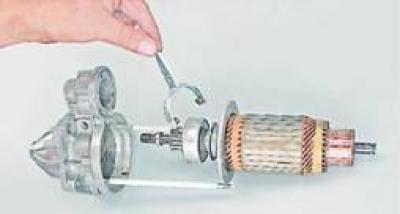
12. Having rested the armature shaft on a wooden surface, with a suitable mandrel we press the restrictive ring from the retaining ring.

13. Prying with a slotted screwdriver, remove the retaining ring from the shaft.
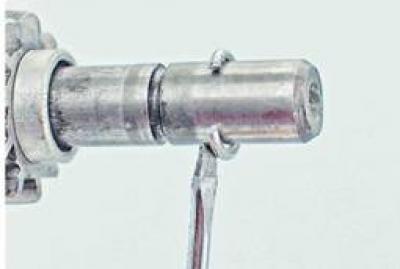
14. Remove the restrictive ring from the armature shaft, the overrunning clutch with the drive gear and the bulkhead of housing A.

Starter assembly 4216.3708-02
1. We wash the starter parts with white spirit or kerosene, blow it with compressed air. Checking the condition of the parts. Covers and body must be free of cracks. Gear teeth should not show significant wear. The gear should easily rotate relative to the hub in only one direction - in the direction of rotation of the armature. On the surfaces of the splines and pins of the shaft there should be no burrs, nicks or wear marks. There must be no burns on the working surface of the collector. We remove small burns with fine-grained sandpaper. The brushes must move freely in the grooves of the brush holders. brush holders "positive" brushes should not have a short circuit with "weight". Worn to a height of less than 12 mm, the brushes are replaced with new ones.
2. Lubricate with engine oil the bearing surfaces and splines of the armature shaft, the splines of the overrunning clutch hub, the bearing bushings in the starter covers and the axis of the drive lever. Lubricate the drive ring of the overrunning clutch hub with grease.
3. We install a partition and a freewheel with a drive gear on the armature shaft.
4. We put the limiting ring of the gear travel on the shaft so that the smaller diameter of the inner conical surface of the ring faces the gear. We install a retaining ring in the groove of the shaft, crimp it and press the restrictive ring onto it with sliding pliers, if necessary, sinking the retaining ring into the groove with a slotted screwdriver.

5. Next, assemble the starter in reverse order.
6. Before installing the armature shaft casing, we check the axial play of the armature shaft, which should be no more than 0.5 mm. If necessary, adjust it by installing shims on the armature shaft (see above "Starter repair 4216.370802", item 5).
7. Install the casing.
8. Install the eccentric axis of the gear drive lever. By pressing the lever, we check the movement of the clutch. The rollers of the lever must not come out of the grooves of the ring. If necessary, adjust the position of the lever by rotating the axis. With a 10 mm wrench, we wrap the nut, holding the axis with a slotted screwdriver from turning.
9. Install and connect the traction relay.
Starter repair 5722.3708
1. Using a 10 mm socket wrench, unscrew the nut that secures the wire tip to the terminal (contact bolt) traction relay.

2. Remove the wire tip from the contact bolt of the traction relay.

3. Using an 8 mm socket wrench, unscrew the two bolts securing the traction relay.

4. Remove the traction relay from the starter (in this case, it is necessary to disconnect the earring of the relay core from the upper end of the drive lever).

Recommendation. Check the ease of movement of the core of the traction relay. Connect an ohmmeter to the terminals of the traction relay and, sinking the armature to the stop, make sure that the contact bolts close (electrical resistance close to zero). A defective traction relay must be replaced.
5. Using a 10 mm socket wrench, unscrew the two nuts of the tie rods.
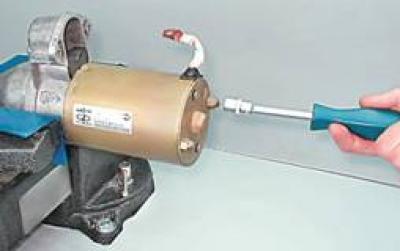
6. Having carefully disconnected the stator from the front cover, remove the stator from the studs.

7. Remove the central gear of the planetary gearbox (sometimes the gear remains on the armature shaft).
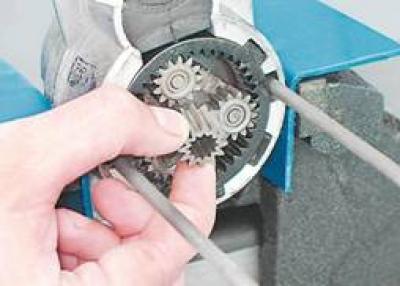
8. Using a slotted screwdriver, remove the three planetary gears of the gearbox one by one.

Recommendation. Check the condition of the planetary gear. The needle bearings of the satellite gears must not be damaged. The teeth of the gears of the reducer should not have chips, scuffs, traces of corrosion and other damage. It is necessary to replace the defective elements of the gearbox (either drive or starter assembly).
9. Using a screwdriver, resting on the top of the front cover of the starter, pry off the support of the drive lever.

10. We remove the drive from the cover together with the drive shaft, the drive lever, the lever support and the external gear of the gearbox.

Recommendation. Check drive condition. The drive must move freely without jamming along the splines of the shaft. The drive gear must be freely screwed in only one direction, chipping of the teeth and strong nicks on the lead-in part of the teeth are not allowed. Minor defects can be eliminated with a diamond file or an abrasive stone. It is necessary to replace a faulty and badly worn drive (or starter assembly).
11. With a hammer, through a 13 mm open-end wrench, knock down the ring of the starter drive stroke limiter (at the same time, a wooden block or a piece of hard rubber should be placed under the gear of the gearbox).

12. Using a slotted screwdriver, remove the stop ring of the drive travel stop from the groove of the shaft and remove the stop ring and travel stop ring from the shaft.

13. Remove the drive assembly with the lever and the clutch from the shaft.
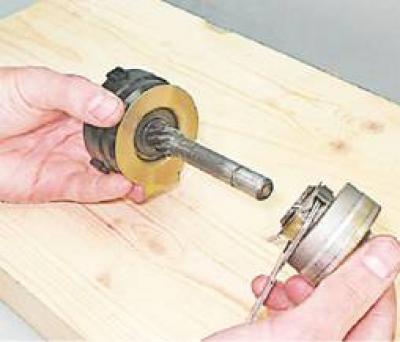
14. Using special expanding tongs, remove the retaining ring of the drive lever coupling.

15. Remove from the drive (4) puck (2), clutch (5) complete with drive lever (3).

Comment. When replacing only the drive, further disassembly of the starter can be omitted.
16. Remove the retaining ring with special expanding tongs (see photo p. 17, pos. 6) drive shaft support.

17. With shaft drive (1) sequentially remove the thrust washer (5), shaft support (4), sealing rubber ring (3) and the outer gear of the planetary gearbox (2).

18. Using a Phillips screwdriver, unscrew the two screws securing the brush assembly to the rear cover of the starter.

19. Remove the back cover.

20. Prying with a slotted screwdriver, remove the brush assembly from the armature collector.

21. Remove the front armature shaft support.

22. Remove the thrust washer from the armature shaft.

23. Overcoming the force of the magnets, we remove the anchor from the stator.

24. We inspect the collector and armature windings.
Comment. Traces of charring of the windings are not allowed - such an anchor must be replaced.
25. We clean the polluted collector with fine-grained sandpaper ("zero"), holding the armature shaft through a strip of thick paper into an electric drill chuck. We wash the anchor with water and detergent to remove dirt, coal dust and abrasive residues and carefully wipe it dry with a clean rag, blow it with compressed air from a tire pump.
26. Replace worn brushes (the height from the working edge to the output is equal to or less than 3.5 mm) and brushes with mechanical damage.
27. We wash the parts of the gearbox and drive with white spirit or kerosene.
Starter assembly 5722.3708
You can install the brush assembly on the starter armature collector using a special mandrel or tool head of a suitable size and shape. In case of their absence, brushes can be installed without these devices. For this:
1. Fasten the brush assembly to the back cover of the starter with two screws.
2. Lubricate the end of the armature shaft with two drops of engine oil.
3. We insert four brushes into the corresponding brush holders. Without inserting the brush springs into the brush holders, we put the brush assembly on the armature collector.
4. Using pliers with thin sponges, we bend the outer stops of the springs of all four brushes.

5. Insert the spring into the brush holder.

6. Holding the spring with a screwdriver, bend the four stops of the spring with pliers. Install the other three springs in the same way.
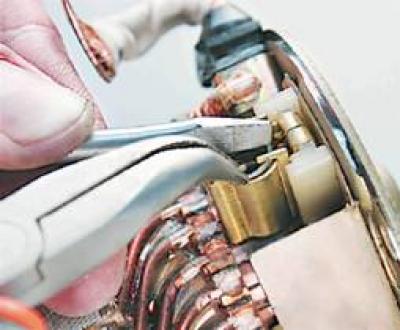
7. We insert the starter anchor into the stator with the brush assembly and rear cover put on it (at the same time, it is necessary to hold the anchor so that its collector does not disengage from the brush assembly).
Further assembly of the starter is carried out in the reverse order of disassembly. At the same time, grease is applied to the parts of the gearbox. Before installing the drive, dip it in engine oil and let the oil drain. The bushings in which the armature and drive shafts rotate, as well as the screw splines of the drive, are lubricated with engine oil.
8. To make sure that the starter is assembled correctly, before installation, we check its performance, as shown at the beginning of the section.
